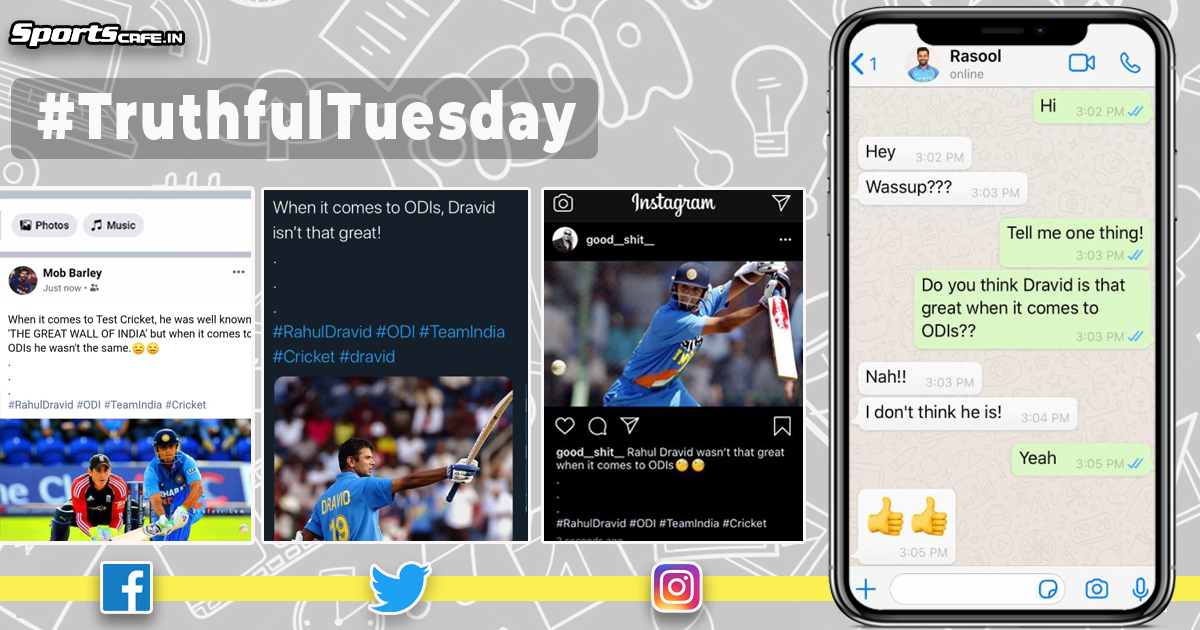Truthful Tuesday | Rahul Dravid - an understated ODI genius
The problem of being an understated sportsman for the majority of your career is that you tend to become overstated at times for things that you are and for things you probably are not. In between the hyperbole, the reality may slip under the radar - cue Rahul Dravid’s ODI career.

Dravid, whom Harsha Bhogle once rightfully called a wolf who lived for the pack, was the intermittent example of a storied career. Life happened for him in between. When the world was glued to Sachin Tendulkar’s out of the world straight drive, Dravid blossomed. When the world was hailing the wristy genius of VVS Laxman, Dravid prospered. It was the dichotomy in which Dravid became an understated persona - a genius in whites, often labelled lower in ODIs than he deserved.
But why was it so? How many cricketers can we name who have overcome the milestone of 10,000 ODI runs yet talked only about his Test exploits? After Sachin Tendulkar, following the footprints of Mark Greatbatch, dazzled ODI cricket with a string of powerful performances as an opener, Dravid emerged from the slow and beautiful stage of Test cricket to score 3, 4, 3, 11 and 13 in his first five completed innings, but what about the next 10-odd years?
It was easy to write him off then but then came Toronto, where India played a five-match Friendship Cup against Pakistan, and the slow wicket played to his hands and he top-scored in two of those games before scoring his maiden century in a match remembered for Saeed Anwar's record-breaking 194. He went on to play 344 matches, winning 14 Man-of-the-Match awards in the process and was among the most successful ODI batsmen in the world but was never talked about in the same vein as most of his contemporaries.
The 1999 World Cup was definitely the high-point and that Taunton partnership with Sourav Ganguly showed the world his excellent ability to work on his game and improve. He exposed himself with more rigorous training, started freeing himself up a bit and instead of trying to become flamboyant, he became more useful to the set-up. So much so that the six-year period from 1999 to 2005 saw him breaking the shackle to be among the best in the world. As a matter of fact, among those who scored a minimum of 4000 runs during that phase, only Damien Martyn, Jacques Kallis, and Sachin Tendulkar had a better average than him with Dravid’s 63 fifty-plus scores being the best of the lot.
Sans that, Dravid kept wickets for India at a time when runs from wicket-keepers if you are not Adam Gilchrist, came at a premium. Dravid did that with perfection for 73 times in his career, and if you think his batting would have been compromised, let me disappoint you: he scored 2,300 runs at an average of 44. A bit of trivia - Dravid’s first match as a wicket-keeper for India was against Sri Lanka in Taunton in the 1999 World Cup, in which he smashed 145 off 129 balls while sharing a 318-run stand with Ganguly.
Then why was Dravid so scrutinised whenever he traded the whites for some colour on his clothes? The only possible reason that I can imagine was the insane number of runs he scored in Test cricket during that period, something that made him a popular figure among the romanticists. In the last edition of Throwback Thursday, we discussed India's Adelaide Test win - something that remained an immortal victory in Indian cricket. Dravid was the architect of it. Do I really need to talk about his contribution in the 2001 Australia series? Every time Dravid did something remarkable in Test cricket - be it at Leeds 2002 or Rawalpindi 2004, be it Georgetown 2002 or Kingston 2006 - fans and followers had a little downtime to remember him in the ODIs. He had a calming presence but the dazzling artistry of Sourav Ganguly-Sachin Tendulkar partnership was an eye-popping one.
The former Indian skipper, who assumed the full-time captaincy in the mid-2000s, saw his form plummeting from which he could really recover from. In the last six years of his career, Dravid played just 69 matches, scoring 2046 runs at 35.27. That he could hit only one century might take some shine off it but the glittering career was characterised by the changing scenario in the Indian team.
After getting rid of him from the ODI set-up in late 2009 to build a team for the World Cup, MS Dhoni and the selection committee helplessly brought him back for the England ODI series in September 2011 and even-handed him his maiden T20 cap. If the word reliability existed in the dictionary, it was that.
He came back, played a beautiful sweet cameo in the only T20I while ensuring his 69 in the last ODI of the tour in Cardiff became a fine passing of the baton to Virat Kohli, who was at the other end during his dismissal. It was a classic reminder of what Dravid meant for the Indian ODI side for those 15 years - an ever assuring presence but never the one to take centre stage. As we go along to be wowed by the likes of Virat Kohli, Rohit Sharma, Shikhar Dhawan, and KL Rahul, the immersive experiences of Rahul Sharad Dravid will live on to sing the glory for years to come to celebrate an absolute legend of the sport.

Comments
Sign up or log in to your account to leave comments and reactions
0 Comments